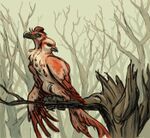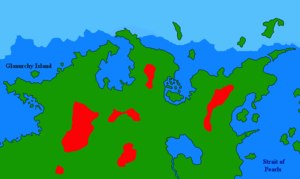Aeagle: Difference between revisions
No edit summary |
No edit summary |
||
| Line 9: | Line 9: | ||
|habitat = | |habitat = | ||
|discovery = {{AN|1173}} | |discovery = {{AN|1173}} | ||
|locale = {{team flag|Lac Glacei}}, {{team flag|Hurmu}}, {{team flag| | |locale = {{team flag|Lac Glacei}}, {{team flag|Hurmu}}, {{team flag|Iselande}} | ||
|related = None | |related = None | ||
|danger = Vulnerable | |danger = Vulnerable | ||
Latest revision as of 05:52, 30 August 2023
Scientific Name: Falco polycephalous  |
|
Physical Description Body Type: Raptor Biological Information Diet: Carnivorous |
The aeagle, also called the double-headed eagle, is a species of bird native to the northeastern quarter of Apollonia. It is a very large raptor, 66 to 102 centimetres (26 to 40 in) in length. Its wings are broad and the wingspan is 1.8 to 2.81 m (9 ft 3 in) and a mass of 12.1 kg (27 lb). It is unique in that the entire species is polycephalic. Wild aeagles are somewhat rare and their native range is limited to higher elevations in rocky cliffs. Although some have been tamed for falconry, this is not a common practice and the aeagle remains an undomesticated species. Since they are exclusively found in northeastern Apollonia the species is considered vulnerable.
The aeagle is the national animal of the Anglo-Saksen Commonwealth.
